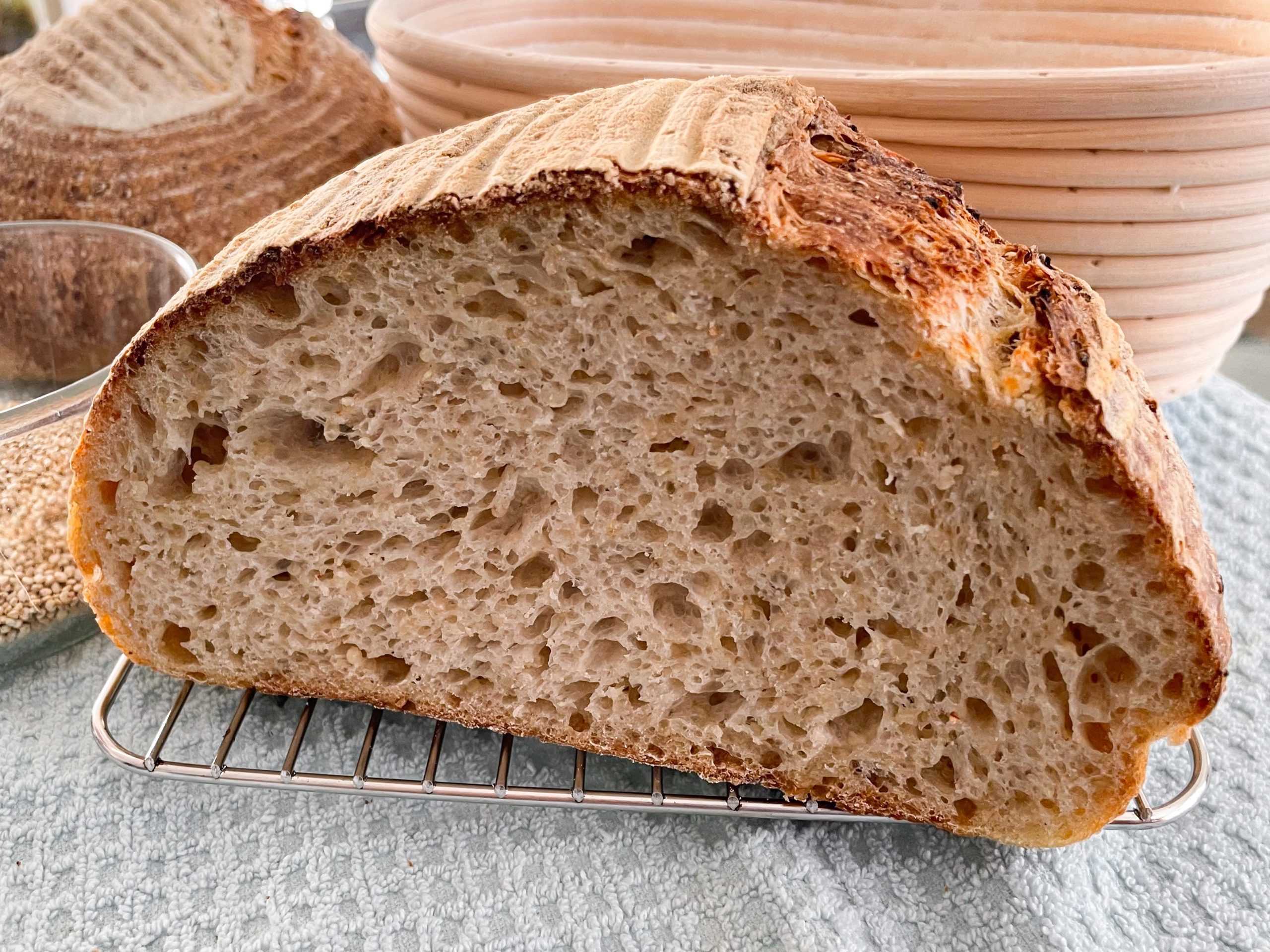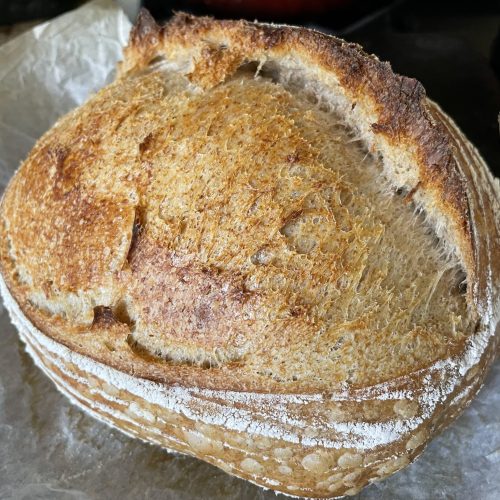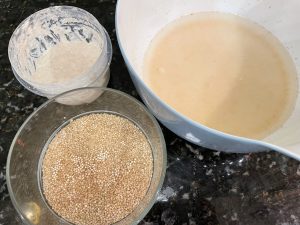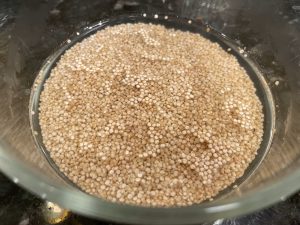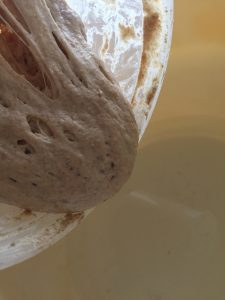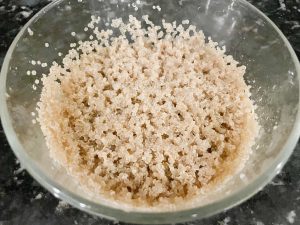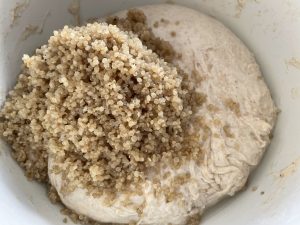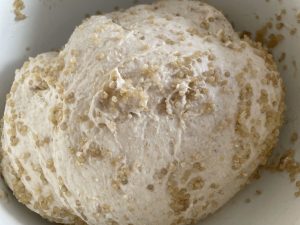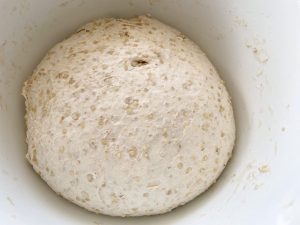I developed this high-protein quinoa sourdough bread recipe by accident. I was visiting my daughter in Miami and brought "Poolish" (the name of my starter) with me. Since I was going to be here for a few weeks, I was thinking of a bread that was high in protein and fiber. I rummaged through the pantry and found a bag of quinoa. I know the health benefits of quinoa as a result of developing the lemony high-fiber quinoa salad so I decided to incorporate this into the bread but finding a process that would be more conducive to bread making. After several tries, this procedure is the most effective. The end result is this high-protein sourdough bread that is moist, has the texture of regular bread and a hint of nuttiness from the quinoa. It's soft, delicious and full of extra health benefits.
According to Healthline.com, here are the nutritional facts about quinoa.
The nutrition facts for 3.5 ounces (100 grams) of cooked quinoa are:
- Calories: 120
- Water: 72%
- Protein: 4.4 grams
- Carbs: 21.3 grams
- Sugar: 0.9 grams
- Fiber: 2.8 grams
- Fat: 1.9 grams
It has a high protein and fiber content with more vitamins and minerals than other "grains". According to other health websites, kamut, teff, amaranth, quinoa, and farro are 5 of the top protein-rich grains. Quinoa is readily available in supermarkets. It is also a complex carb and easy to cook.
Tips for making high-protein quinoa sourdough bread.
Types of quinoa.
Quinoa comes in a variety of colors: white, red or black. All the colors have the same nutritional value. The combination of colors makes for an interesting bread. I happened to just have the white quinoa on hand so that is what I used. Quinoa can be found in most grocery stores.
Instead of cooking the quinoa, I soaked the quinoa with a 1 : 1.75 quinoa to water ratio OVERNIGHT at the same time as I soak the whole wheat flour.
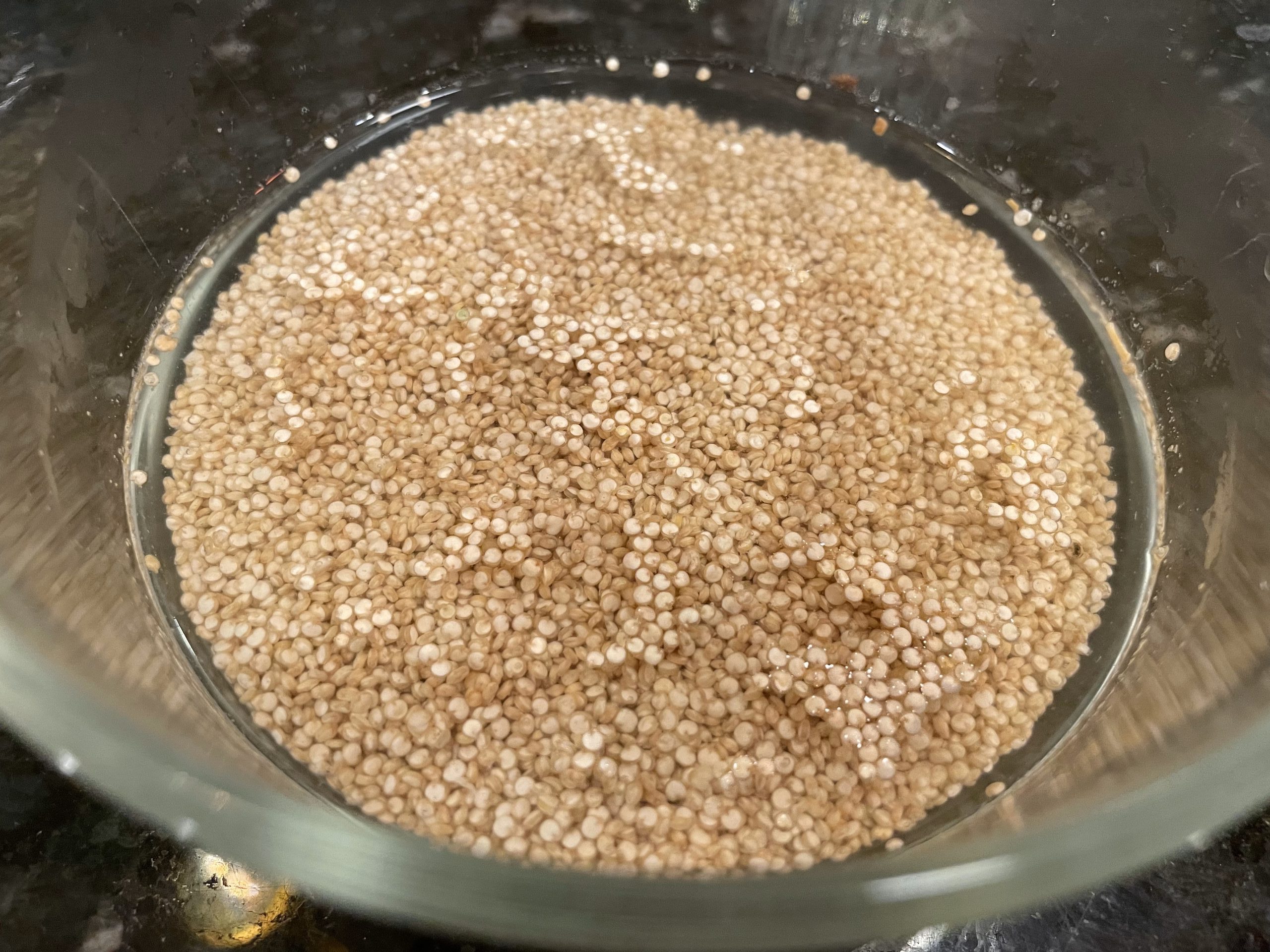
Soaked raw quinoa
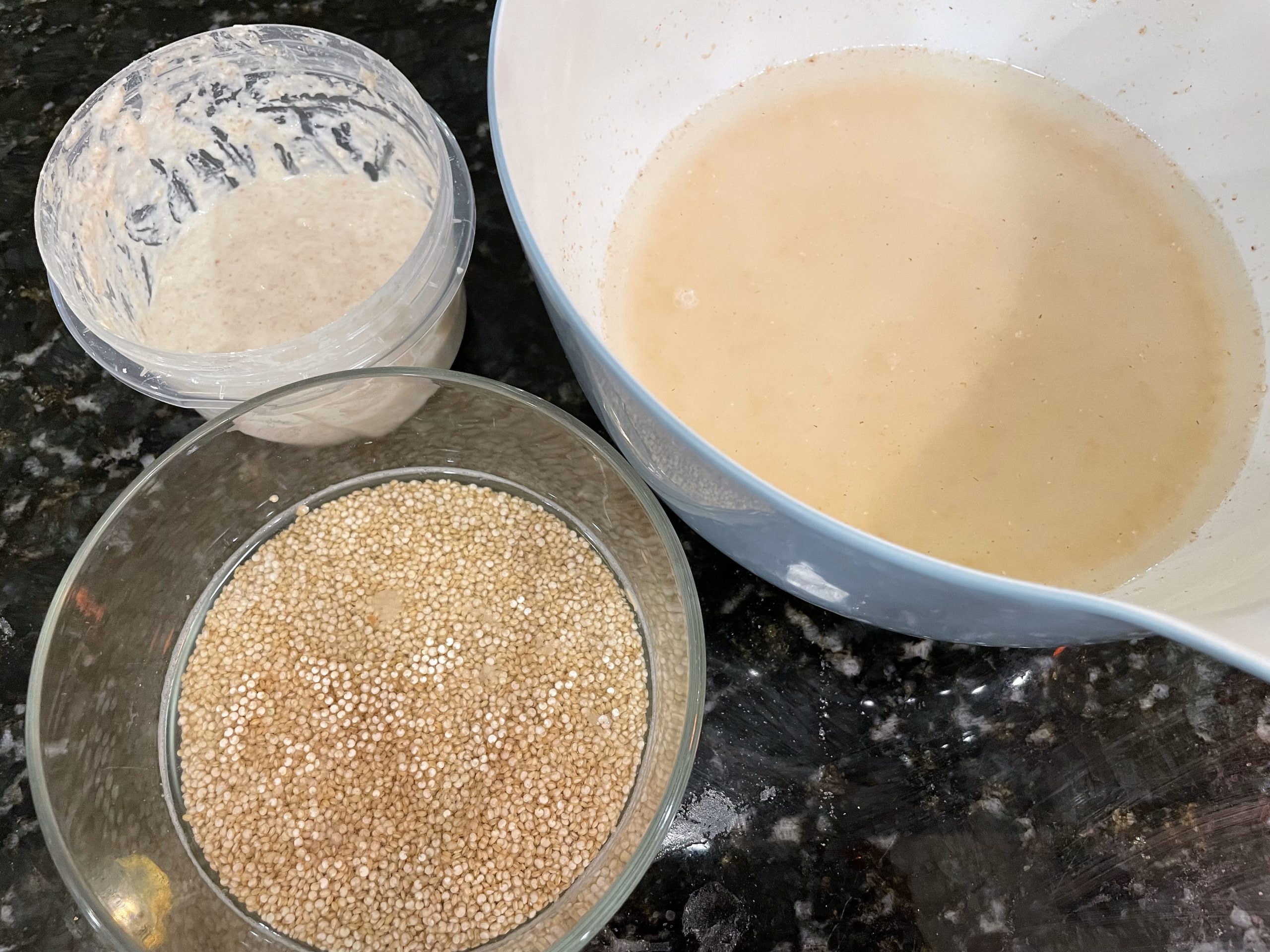
Soak whole wheat flour, quinoa and make the levain at the same time.
After soaking, cook the quinoa in the microwave for 1-2 minutes until the water boils up and the quinoa changes color and appears hydrated. Halfway through the microwaving time, stir to make sure that the quinoa cooks evenly. There may still be a little water left in the bowl.
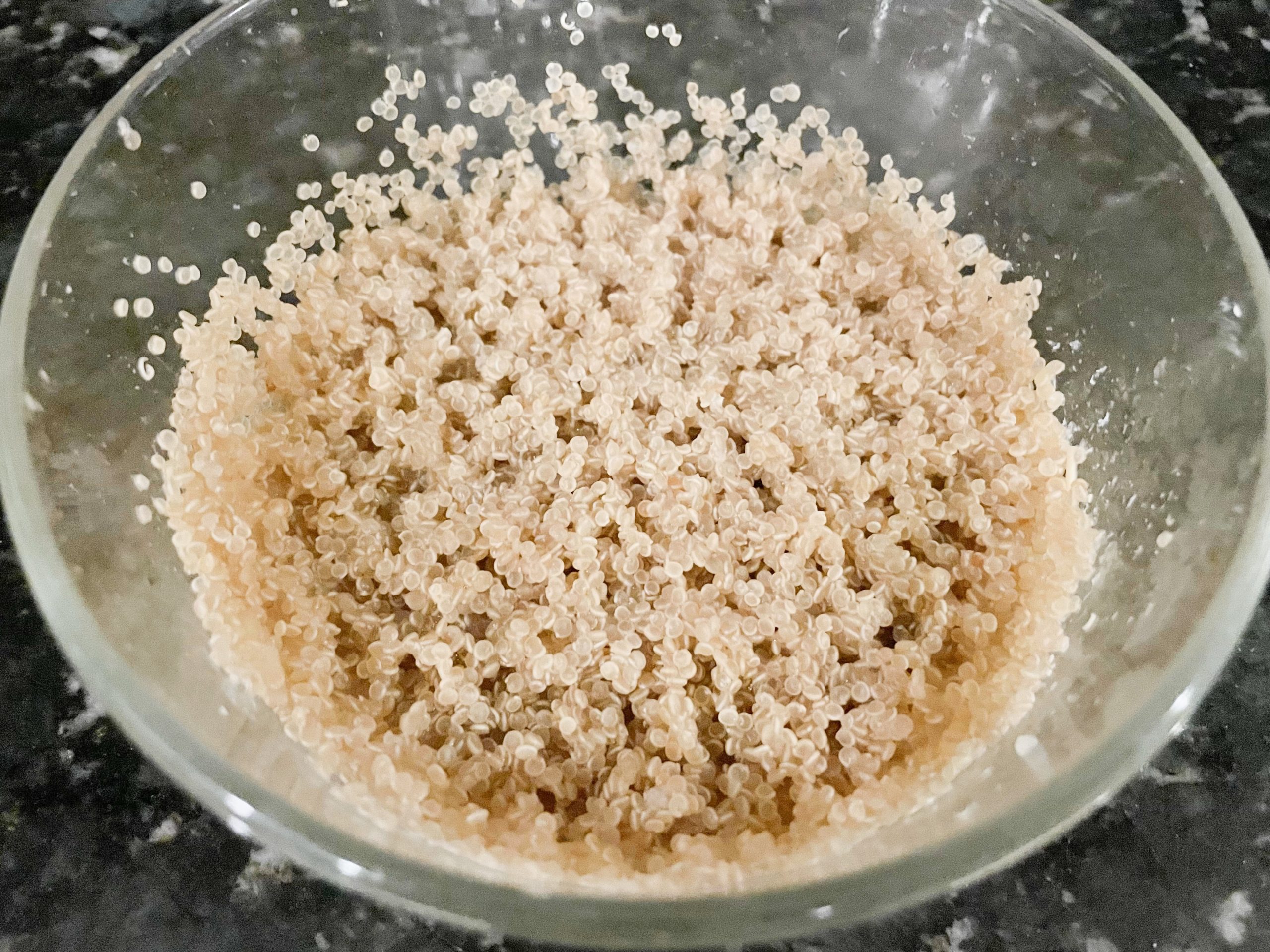
Microwaved quinoa.
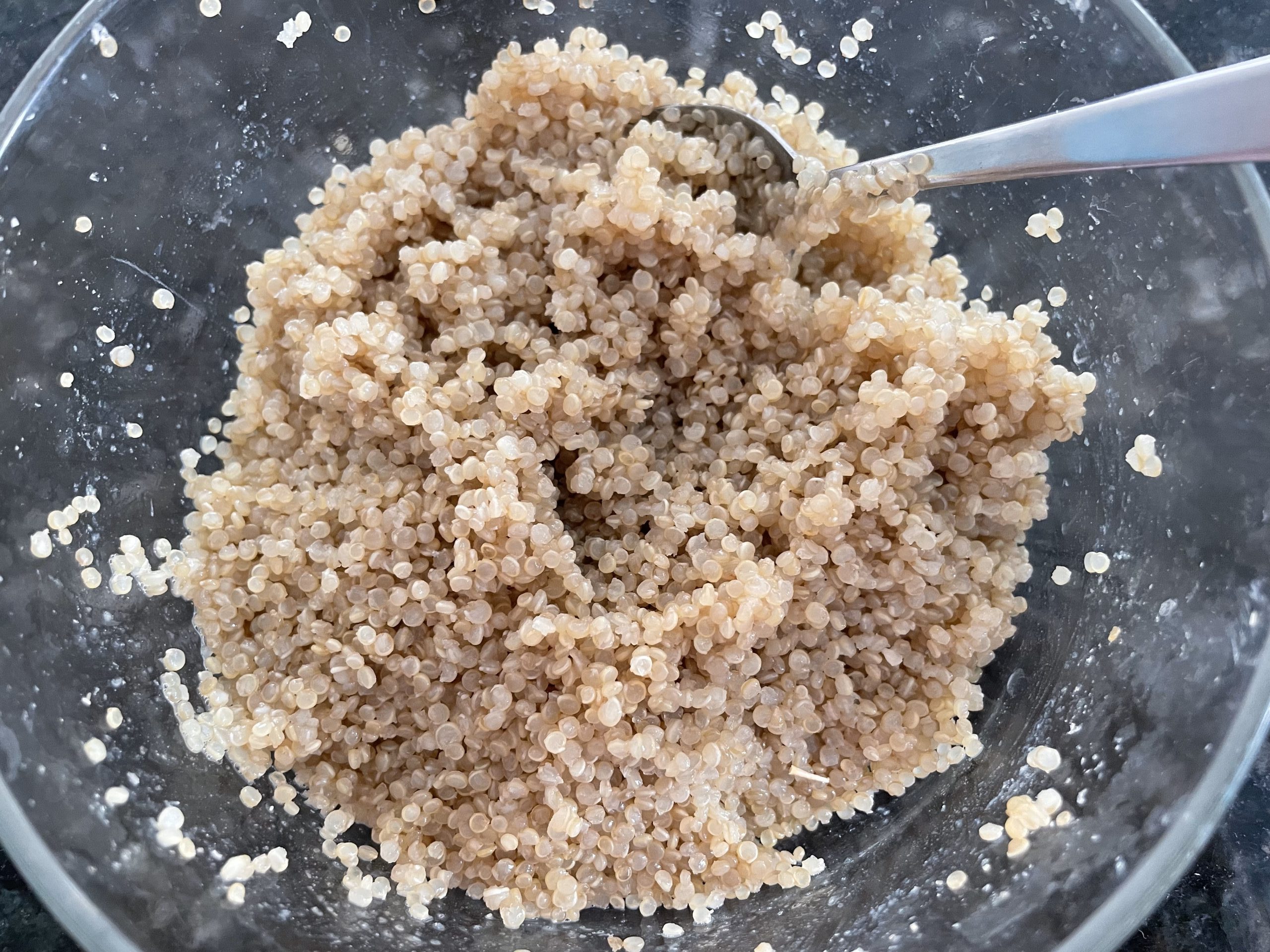
Microwaved quinoa. A little water still remains.
Allow the quinoa to cool while the bread is autolyzing. After this time, the quinoa will completely absorb the water and no water will be left in the bowl. When adding the quinoa to the dough, if there is any water left, drain the quinoa through a sieve to remove the remaining water. The quinoa should be cooked and dry. It needs to be cooked so that it will not absorb any additional moisture from the dough, resulting in a drier bread. However, there should also NOT be any excess water so that no additional moisture is added to the dough, resulting in a sticky dough.
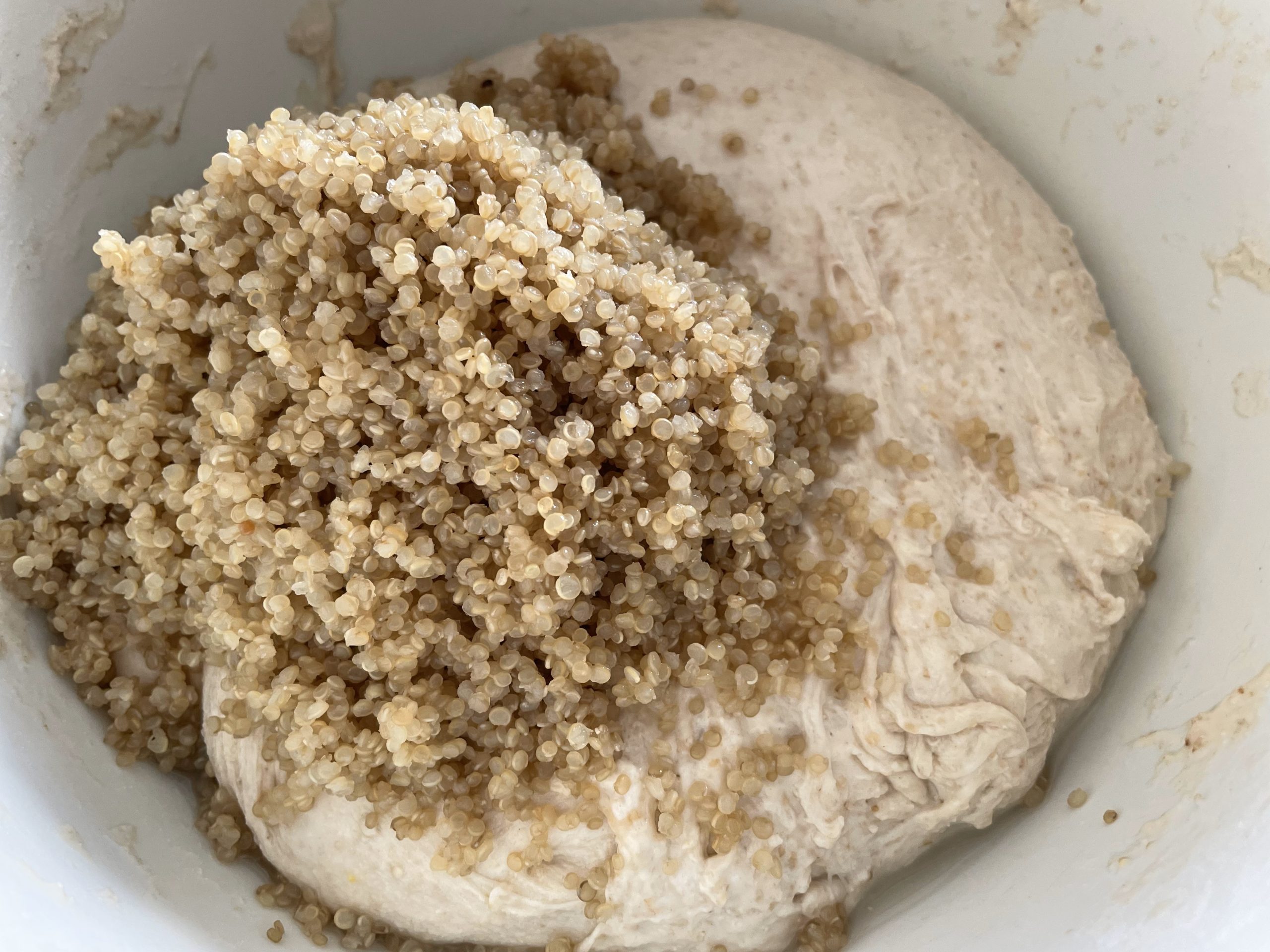
Add cooked and cooled quinoa to the bread dough.
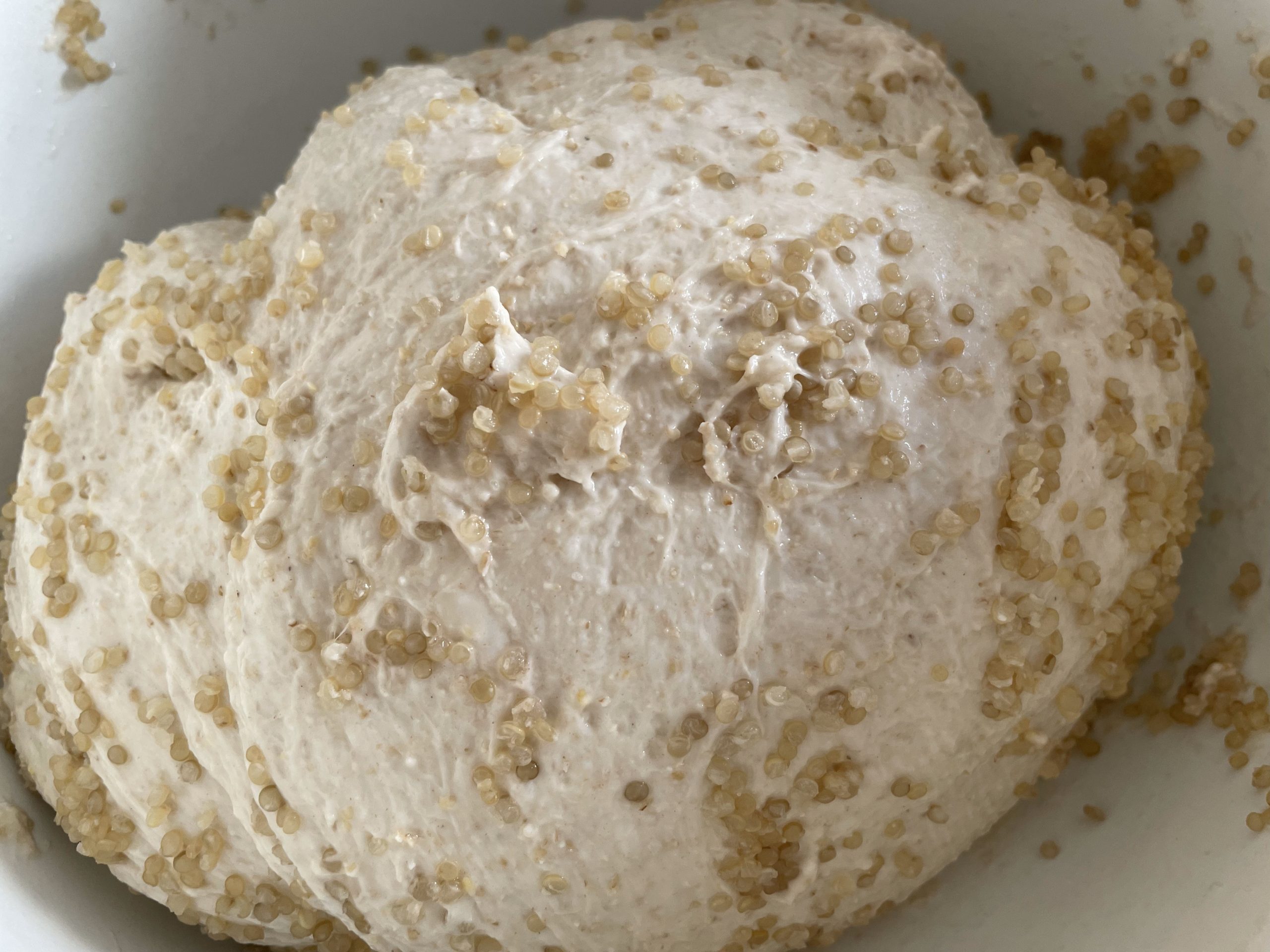
Incorporated quinoa after 3 stretch and folds.
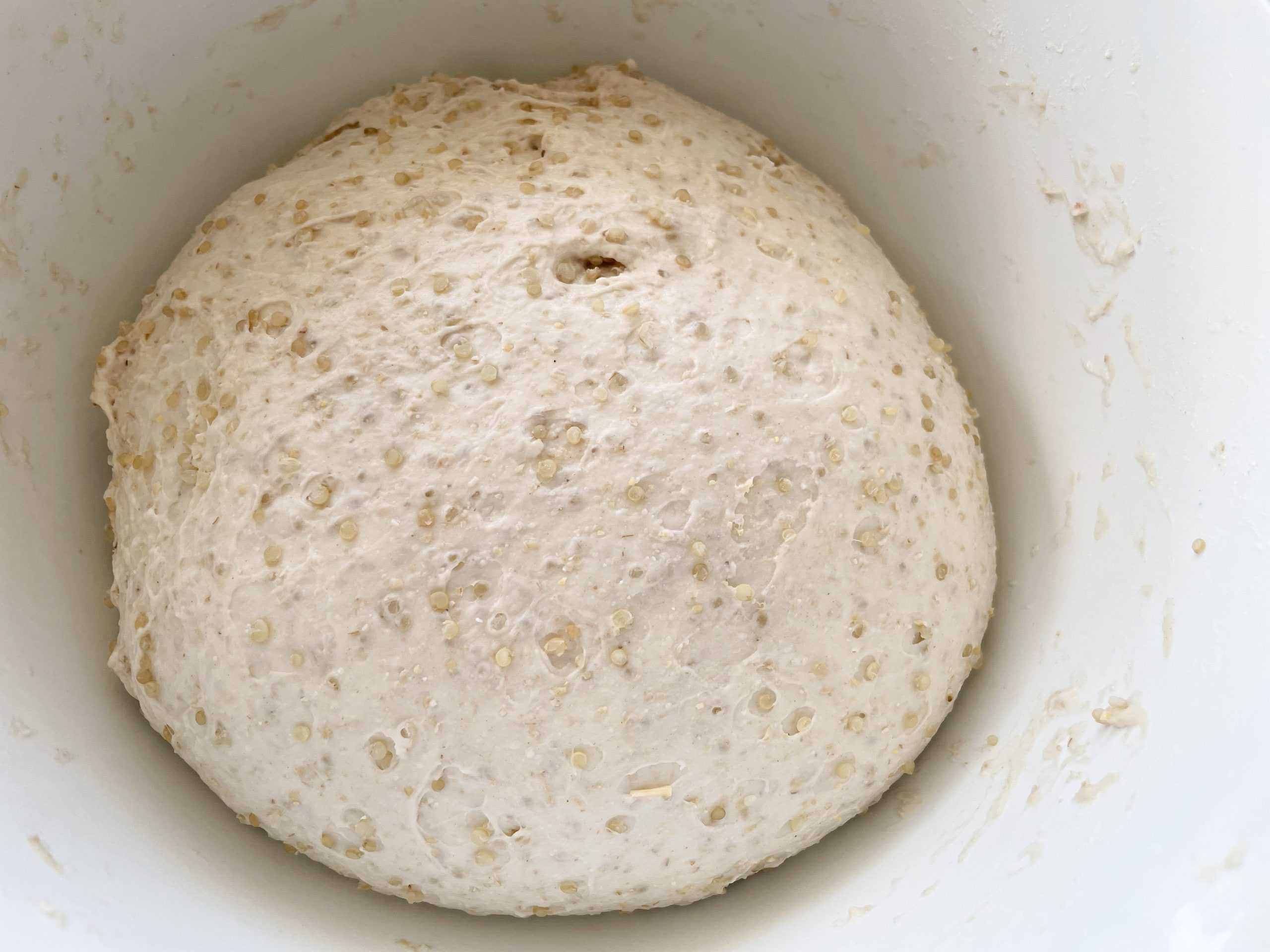
Fully incorporated quinoa into sourdough.
For this high-protein quinoa sourdough bread, the process is similar to the basic sourdough bread except for the addition of quinoa and the way it is processed.
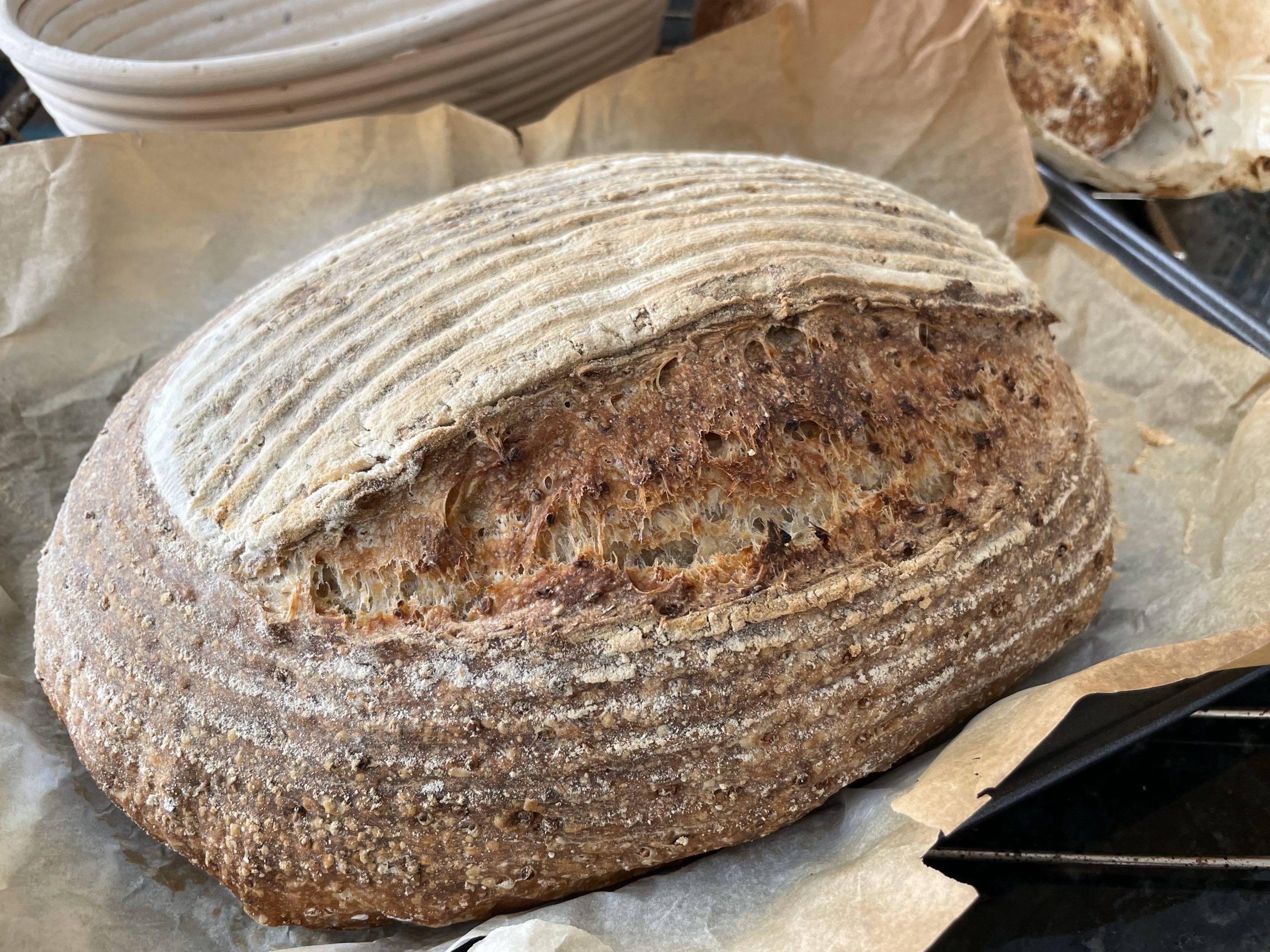
High protein quinoa sourdough bread
Enjoy this hearty, healthy high-protein quinoa sourdough bread!
HIGH PROTEIN QUINOA SOURDOUGH BREAD
Equipment
- Cast Iron dutch oven
- 2 Large Bowls
- Bread lame, razor or pair of scissors
- Dish towel to cover dough
Ingredients
- 350 grams water Room temperature water
- 400 grams bread flour
- 100 grams whole wheat flour
- 9 grams salt
- rice / bread flour mixture Used for dusting your proofing bowl / banneton
- 100 grams levain See "What is levain and how to make it"
- 60 grams quinoa
- 105 ml water
Instructions
Preparing your ingredients
- Prepare you levain, making sure it is very active.100 grams levain
- Measure and soak your wheat flour.100 grams whole wheat flour, 350 grams water
- Measure and soak the quinoa in water.60 grams quinoa, 105 ml water
Making your bread dough
- Sift you bread flour into a bowl. I do this because some bread flours are very refined and clumpy. Sifting helps remove those clumps.400 grams bread flour
- In another bowl, add your levain to your water-whole wheat flour mixture and stir to combine. The levain does not have to dissolve.
- Mix in your bread flour and let sit for 45 minutes. This allows your dough to autolyze, allowing the flour to completely absorb all the liquid making it easier to work with.Set timer for 45 minutes
- Microwave the quinoa with the water for 1 -2 minutes until the water seems to be boiling. Stir. If some quinoa granules look raw, continue microwaving until the quinoa has a uniform color. Allow to cool and the water to completely absorb into the quinoa.
Bulk fermentation.
- The dough is now ready for bulk fermentation where it will develop its flavor and body! Ambient temperatures between 70-80 degrees Fahrenheit will take 3 hours for bulk fermentation
- Add salt after the dough has autolyzed.9 grams salt
- I stretch and fold the dough by hand...very therapeutic. Using wet hands, I pull and stretch the dough out at the top and fold it back on itself, I then rotate the dough a quarter turn and do the same thing 16 times. (4 complete revolutions!)
- Let dough rest for 30 minutes. You will notice that the dough will become more pliable with time. Cover and let sit for 30 minutes. Don’t forget to set your timer! Set timer for 30 minutes
- Add the cooked quinoa.
- It is also at this time when I will add add-ins to the dough. Stretch and fold.
- Let it rest for 30 minutes.Set timer for 30 minutes
- Stretch and fold.
- Let dough rest for 30 minutesSet timer for 30 minutes
- Stretch and fold.
- Let dough rest for 30 minutesSet timer for 30 minutes
- Stretch and fold.
- Let dough rest for 30 minutesSet timer for 30 minutes
- Stretch and fold.
- Let dough rest for 30 minutesSet timer for 30 minutes
- Stretch and fold. The dough should be soft and pliable. If not, continue bulk fermentation for another 30 mins - 1 hour.
Shaping your bread dough.
- Pull dough out of the container. You can make smaller bolles by using about 250 grams of dough (a half of your recipe). See Cutting and Shaping your Dough in my Tips & Tricks section.
- On a floured surface, lightly dust your dough with flour and work it into a round by pulling it towards you and rotating. It should become somewhat taut as you pull the dough, part of your goal is to remove most of the air bubbles that were created during the fermentation process. I have found that if you keep these air bubbles, your bread will be very porous with a lot of air bubbles (almost like a ciabatta). Some people like this, other people want a little more substance.
- Let it sit for 15 minutes. Set timer for 15 minutes
- Shape again. See Cutting and Shaping your Dough in my Tips & Tricks section.
- Prepare your banneton (Coiled rattan baskets for proofing) by generously dusting the bowl or banneton with your bread and rice flour mixture. Dust the tops of your loaves with flour and place it in a bowl or banneton with the dome side on the bottom of the banneton.rice / bread flour mixture
Proofing your dough - Quick Proof (not recommended)
- Cover your banneton with a damp cloth and let rise in a warm place for 2 hours. I usually put this in my oven with the oven light on.Proof dough for 120 minutes
- Take your dough out and preheat oven to 500° fahrenheit (260° Celcius) with your cast iron dutch oven in it. (Should take about an hour depending to get your cast iron pot to the desired temperature.) This will be a total of 3 hours of proofing. I have proofed bread for 4 hours. However, overproofing your dough with cause your dough to lose its ability to have enough strength for the "oven-spring" (the last rise in the oven as a result of intense heat).
Proofing your dough - Slow Proof (recommended)
- Allow dough to proof at room temperature for one hour before cold proofing.
- Place your banneton in a plastic bag. Seal it with a clip. Place it in the refrigerator for 12-48 hours. Highly recommend a 48 hour proof for the dough to develop its flavor
- Preheat oven to 500° fahrenheit (260° Celcius) with your cast iron dutch oven in it. (Should take about an hour depending to get your cast iron pot to the desired temperature.
Scoring your dough.
- The dough should be fairly firm but not impossible to handle after (cold) proofing. Take a piece of parchment paper that will generously cover the top of the bowl/banneton. Crumple it so that it folds easily in the pot. Place it over the bowl/banneton.
- Flip the banneton over. The dough is now ready for scoring
- Dust the top of the dough with a little more flour if necessary or brush off excess flour from proofing. Score the bread by cutting it with a razor blade, bread lame, or a pair of scissors. Scoring the bread allows for oven spring when the dough expands quickly during baking and gives your dough a pretty design. See Scoring your dough in my Tips & Tricks section.
- Gently lower your scored bread into the dutch oven. If you have a cast iron skillet / dutch oven set as shown on my "Helpful Tools" section. After scoring, place the dough in the skillet of the set and cover the dough with the dutch-oven section. Place it in the oven with the skillet on the bottom.
- Cover.
Baking your bread
- Reduce oven temperature to 450°F
- Bake for 25 minutes. Smaller 2 quart bolles should bake for 20 minutes.Set timer for 25 minutes for large bolle Set timer for 20 minutes for small bolle
- Remove the lid and continue baking for an additional 25 or 20 minutes respectively.Set timer for 25 minutes for large bolle Set timer for 20 minutes for small bolle
- Remove from oven and remove from dutch oven and let cool on wire rack.
- To bake the second loaf, after removing the first loaf, bring the oven temperature back to 500 degrees, wipe the dutch oven with a clean dry towel, place the dutch oven in it for 10 minutes and bake according to recipe.
- Bread should cool for at least an hour before attempting to slice into it!

